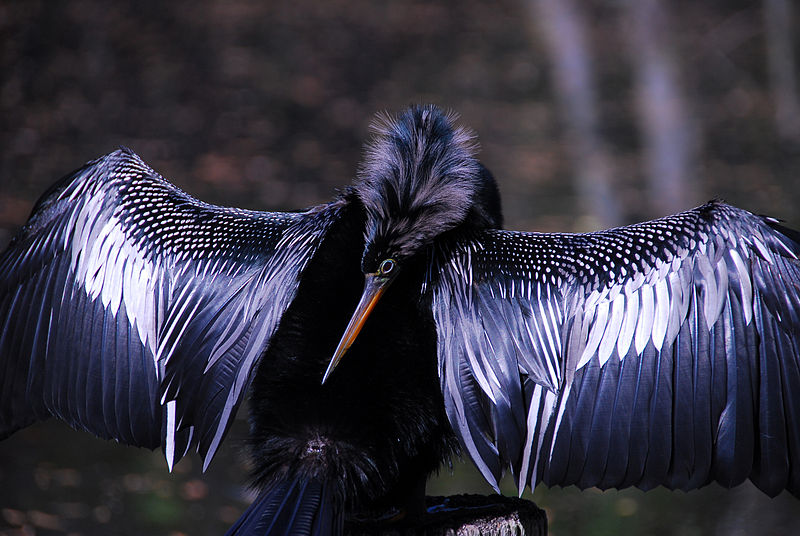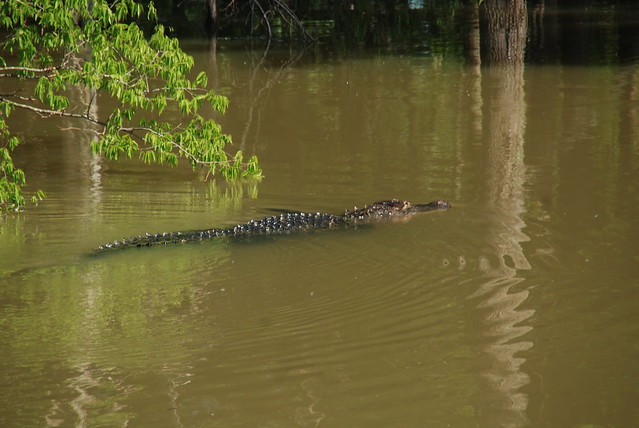We are staying in a beautiful Acadian (remember- Acadian=Cajun), 1880 cypress house in Lafayette, Louisiana while we explore the region's underbelly. We submit ourselves to a local experience: Champagne's (that's the name of the man folks!) Cajun swamp tour. This man and our B&B host are active entrepreneurs. ( I couldn't help but use some French vocabulary here to honor our local culture.) The "hook" advertising picture in Monsieur Champagne's online brochure is the ALLIGATOR and we had to submit to its facial Mona Lisa-like smile invitation. We pile on to a custom made aluminum flat bottom boat with a powerful Evinrude V-6, 250 HP, E-Tec, fuel injected outboard motor...ok, I'm back!- 20 people on board, mostly a Cajun family that hooted and hollered throughout our entire trip. We circumnavigated Lake Martin, in, out, and around stunning cyprus trees, some 500 years old,
over logs and obstructions, squirting through narrow passageways chasing Anhingas and Blue Herons, and learned that the ancient Indian word for Okefenokee was a type of peat that grows in the swamps and bayous so thick and dense that it is possible to walk on it as it floats on the water. Today, this name refers to a swamp location. By the way, there is a difference between a swamp and a bayou. A bayou is a slow moving stream, sometimes very slow. A swamp is more of a boggy wetland that may dry up and then fill seasonally. Here is a link to some of the sounds we heard as we slipped around the margins of Lake Martin, one of the largest concentrations of migratory birds in the world. I was swapping camera lenses and clicking the shutter like a woodpecker, there was so much to see. It was advertised that insect repellent would not be necessary which is counter-intuitive for us city slickers thinking about swamp monsters and blood suckers.
Throughout the two hours we spent on the water it would be possible to guesstimate that we saw millions, perhaps more, of dragonflies darting everywhere, sitting on water lilies, logs, any non moving object including us. Here is a video of a dragonfly in motion shot by David Attenborough's video team, "Life in the Undergrowth."
They were attracted to Ruth's floral-motif tattoos, cruising along and moving about us constantly as we motored along, stirring up whatever meal of bugs was available. Flying up to about 35 miles per hour, a single dragonfly can consume tens of thousands of mosquitoes a day. Multiply that by a million or so of the dragonflies conservatively and there was not a ripple in the force of high-pitched humming or post-bite scratching to disturb our travels. We read history books to feed our fascination with ancient dinosaurs and right there with them were our winged ubiquitous 300,000,000-year-old friends, the dragonflies! Every so often in my classes I'll play a mind game like this to tweak my students' minds: "If one dragonfly eats approximately and conservatively 10,000 mosquitoes every day and there are conservatively one million dragonflies in a lake, how many mosquitoes would be eaten in 300,000,000 years?!" Out come the calculators! If dragonflies weren't in existence would we be speaking mosquito now?!
This is a shot of an Anhiga, a type of cormorant, drying its wing feathers to allow it to fly after diving into the water for food. It is unable to waterproof its feathers like ducks, so when it dives into the water and comes to the surface, it swims like a snake with its head bobbing back and forth to an object for sunning and drying out. We came upon this bird while motoring across the lake and it swam for cover like a Water Moccasin.
What about the "money shot" Alligator, you ask? Except for one set of disappearing eyes out in the middle of the lake, we saw two small gators in the immediate lagoon where our boat was tied up, just sitting there in total stupor. The only movement came when one of the deck hands threw his Marlborough cigarette butt into the water and the gator glided over, lifted an eye, and closed it in disgust...no marshmallows or edibles for "Walle," Quel dommage...



No comments:
Post a Comment